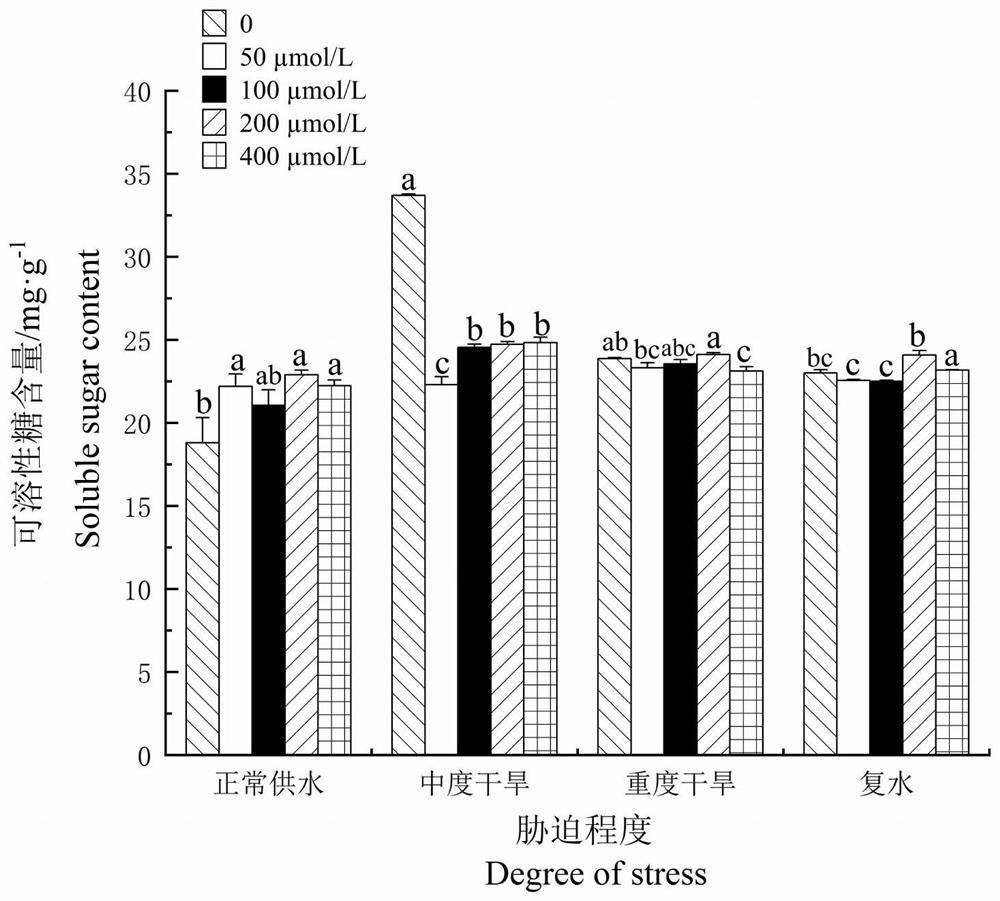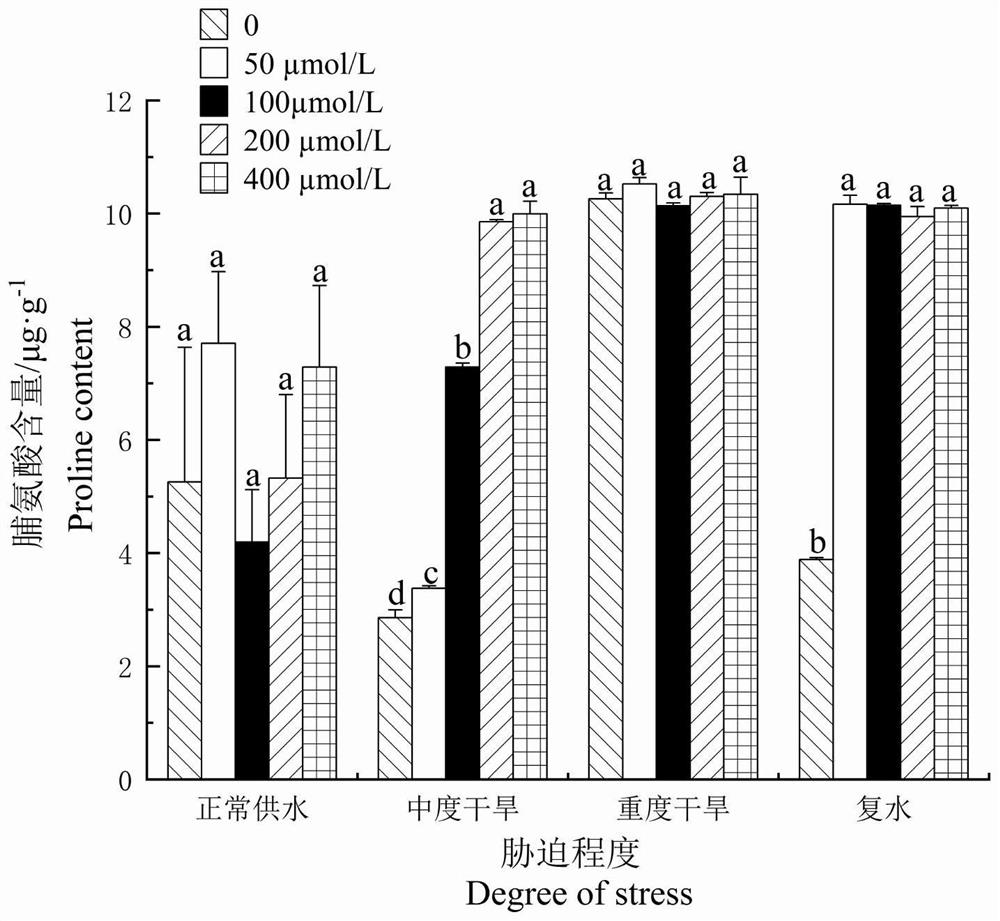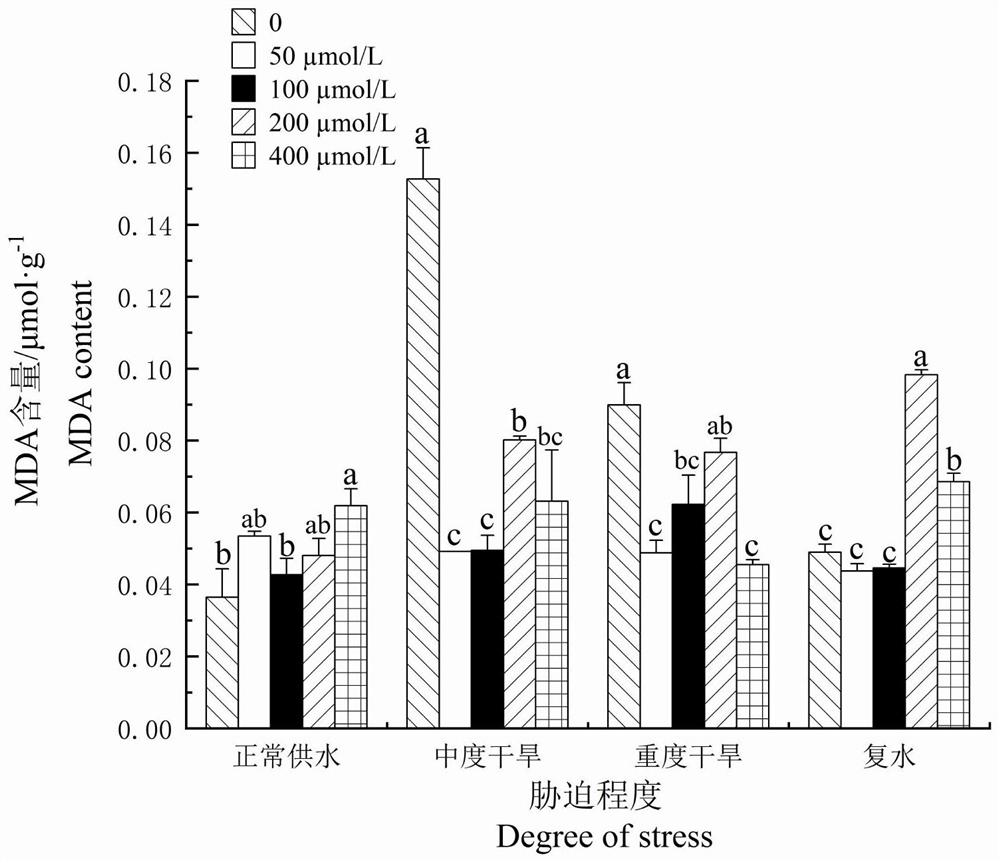Method for improving drought resistance of oil paeonia suffruticosa by adopting jasmonic acid
A technology of using peony and jasmonic acid for oil is applied in horticultural methods, botanical equipment and methods, applications, etc., can solve problems such as normal growth and yield reduction, being susceptible to drought stress, etc., and achieves improvement of net photosynthetic rate and promotion of photosynthesis. , the effect of improving resilience
- Summary
- Abstract
- Description
- Claims
- Application Information
AI Technical Summary
Problems solved by technology
Method used
Image
Examples
Embodiment 1
[0030] A kind of method adopting jasmonic acid (JA) to improve the drought resistance of oil peony, comprises the following steps:
[0031] Step 1: Select three-year-old oil peony 'Fengdan' seedlings with uniform growth and uniform size from the International Peony Garden, and plant them in plastic flower pots with a diameter of 20 cm in October 2018, one plant per pot.
[0032] Step 2: Cultivate in a plastic greenhouse until May of the following year, during which normal water management is carried out.
[0033] Step 3: Spray the whole plant, use 50 μmol / L jasmonic acid, preferably drip water on the upper and lower surfaces of the leaves, and set 5 repetitions for each treatment.
[0034] Step 4: After 50 μmol / L jasmonic acid treatment for 3 days, carry out drought stress (control, moderate drought, severe drought, rewatering treatment), observe its phenotype changes every day, and measure the changes of its photosynthetic performance indicators.
[0035] Step 5: The leaves ...
Embodiment 2
[0037] A kind of method adopting jasmonic acid (JA) to improve the drought resistance of oil peony, comprises the following steps:
[0038] Step 1: Select three-year-old oil peony 'Fengdan' seedlings with uniform growth and uniform size from the International Peony Garden, and plant them in plastic flower pots with a diameter of 20 cm in October 2018, one plant per pot.
[0039] Step 2: Cultivate in a plastic greenhouse until May of the following year, during which normal water management is carried out.
[0040] Step 3: Spray the whole plant, use 100 μmol / L jasmonic acid, preferably drip water on the upper and lower surfaces of the leaves, and set 5 repetitions for each treatment.
[0041] Step 4: After 100 μmol / L jasmonic acid treatment for 3 days, carry out drought stress (control, moderate drought, severe drought, rewatering treatment), observe its phenotype change every day, and measure the change of its photosynthetic performance index.
[0042] Step 5: Take the leaves ...
Embodiment 3
[0044] A kind of method adopting jasmonic acid (JA) to improve the drought resistance of oil peony, comprises the following steps:
[0045] Step 1: Graft seedlings of three-year-old oil peony 'Fengdan' plants with uniform growth and uniform size from the International Peony Garden, and plant them in plastic flower pots with a diameter of 20 cm in October 2018, one plant per pot.
[0046] Step 2: Cultivate in a plastic greenhouse until May of the following year, during which normal water management is carried out.
[0047]Step 3: Spray the whole plant, use 200 μmol / L jasmonic acid, preferably drip water on the upper and lower surfaces of the leaves, and set 5 repetitions for each treatment.
[0048] Step 4: After 200 μmol / L jasmonic acid treatment for 3 days, carry out drought stress (control, moderate drought, severe drought, rewatering treatment), observe its phenotype change every day, and measure the change of its photosynthetic performance index.
[0049] Step 5: The leav...
PUM
 Login to View More
Login to View More Abstract
Description
Claims
Application Information
 Login to View More
Login to View More - R&D
- Intellectual Property
- Life Sciences
- Materials
- Tech Scout
- Unparalleled Data Quality
- Higher Quality Content
- 60% Fewer Hallucinations
Browse by: Latest US Patents, China's latest patents, Technical Efficacy Thesaurus, Application Domain, Technology Topic, Popular Technical Reports.
© 2025 PatSnap. All rights reserved.Legal|Privacy policy|Modern Slavery Act Transparency Statement|Sitemap|About US| Contact US: help@patsnap.com



